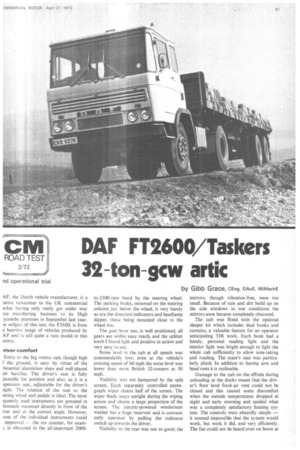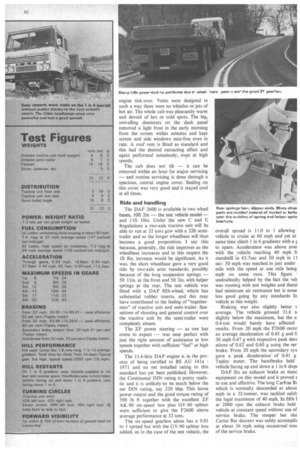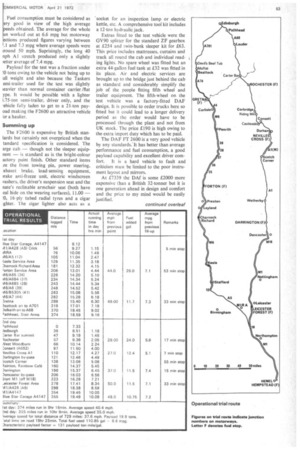DAF FT2600/Taskers 32-ton-gar artic
Page 49

Page 50

Page 51

If you've noticed an error in this article please click here to report it so we can fix it.
by Gibb Grace, CEng. DAuE. MiMechE
AF, the Dutch vehicle manufacturer, is a lative newcomer to the UK commercial arket having only really got under way ice transferring business to its High ycombe premises in September last year. ie subject of this test, the F2600, is from
e heaviest range of vehicles produced by AF and is still quite a rare model in this ,untry.
river comfort Entry to the big roomy cab, though high f the ground, is easy by virtue of the bstantial aluminium steps and well-placed ab handles. The driver's seat is fully justablc for position and also, as it is a spension seat, adjustable for the driver's tight. The relation of the seat to the :ering wheel and pedals is ideal. The most quently used instruments are grouped in binnacle mounted directly in front of the iver and at the correct angle. However, (out of the individual instruments could improved — the rev counter, for exam:4 is obscured in the all-important 2000 to-2500-rpm band by the steering wheel. The parking brake, mounted on the steering column just below the wheel, is very handy as are the direction indicators and headlamp dipper, these being mounted close to the wheel rim.
The gear lever too, is well positioned, all gears are within easy reach, and the splitter knob I found light and positive in action and very easy to use.
Noise level in the cab at all speeds was commendably low; even at the vehicle's cruising speed of 60 mph the noise level was lower than most British 32-tonners at 50 mph.
Visibility was not hampered by the split screen. Each separately controlled pantagraph wiper cleans half of the screen. The wiper blade stays upright during the wiping action and cleans a large proportion of the screen. The electric-powered windscreen washer has a huge reservoir and is conveniently operated by pulling the indicator switch up towards the driver.
Visibility to the rear was not so good; the mirrors, though vibration-free, were too small. Because of rain and dirt build up on the side windows in wet conditions the mirrors soon became completely obscured.
The cab was fitted with the optional sleeper kit which includes dual bunks and curtains, a valuable feature for an operator anticipating TIR work. Each bunk had a handy, personal reading light and the interior light was bright enough to light the whole cab sufficiently to allow note-taking and reading. The mate's seat was particularly plush. In addition to having arm and head rests it is reclinable.
Damage to the cab on the offside during unloading at the docks meant that the driver's floor level fresh-air vent could not be closed and this caused some discomfort when the outside temperatures dropped at night and early morning and spoiled what was a completely satisfactory heating system. The controls were absurdly simple — it seemed impossible that the system would work, but work it did, and very efficiently. The fan could not be heard even on boost at engine tick-over. Vents were designed in such a way there were no whistles or jets of hot air. The whole cab was pleasantly warm and devoid of hot or cold spots. The big, swivelling demisters on the dash panel removed a light frost in the early morning from the screen within minutes and kept screen and side windows mist-free even in rain. A roof vent is fitted as standard and this had the desired extracting effect and again performed noiselessly, even at high speeds.
The cab does not tilt — it can be removed within an hour for major servicing — and routine servicing is done through a spacious, central engine cover. Sealing on this cover was very good and it stayed cool at all times.
Ride and handling
The DAF 2600 is available in two wheel bases, 10ft 2in — the test vehicle model— and 11ft• 10in. Under the new C and U Regulations a two-axle tractive unit will be able to run at 32 tons gcw with a 32ft semitrailer and so the longer wheelbase will then become a good proposition. I say this because, generally, the ride improves as the wheelbase increases and in this respect the lit Sin, increase would be significant. As it was, the short wheelbase gave a very good ride by two-axle attic standards, possibly because of the long suspension springs — Mt llin. at the front and Sit 3in. with helper springs at the rear. The test vehicle was fitted with a DAF fifth-wheel, which has substantial rubber inserts, and this may have contributed to the feeling of "togetherness" of tractive unit and semi-trailer. Sensations of shunting and general control over the tractive unit by the semi-trailer were completely absent.
The ZF power steering — as one has come to expect — was near perfect with just the right amount of assistance at low speeds together with sufficient "feel" at high speeds.
The 11.6-litre DAF engine is in the process of being certified to BS AU 141a : 1971 and no net installed rating to this standard has yet been published. However, the Continental DIN rating is pretty realistic and it is unlikely 'to be much below the net DIN rating, say 220 bhp. This horse power output and the good torque rating of 590 lb ft together with the excellent ZF AK-90 six-speed box plus GV-90 splitter were sufficient to give the F2600 above average performance at 32 tons.
The six-speed gearbox alone has a 9.01 to I spread but with the GV-90 splitter box added, as in the case of the test vehicle, the overall spread is 11.0 to 1 allowing vehicle to cruise at 60 mph and yet at same time climb 1 in 6 gradients with a to spare. Acceleration was above aver with the vehicle reaching 40 mph fi standstill in 65.7sec and 50 mph in 11 sec: 50 mph was reached in just under mile with the speed at one mile being mph on some runs. This figure undoubtedly helped by the fact the veil was running with test weights and there] had minimum air resistance but is none less good going by any standards fo vehicle at this weight.
Braking was also slightly better t average. The vehicle grossed 31.6 t( slightly below the maximum, but the e: 0.4-ton would barely have affected results. From 20 mph the F2600 recor an average deceleration of 0.45 g and fi 30 mph 0.47 g with respective peak &cc ations of 0.62 and 0.60 g using the ser brake. From 20 mph the secondary sys gave a peak deceleration of 0.41 g Tapley meter. The handbrake held vehicle facing up and down a 1 in 6 slop(
DAF fits an exhaust brake as stand equipment on this model and it proved e to use and effective. The long Carfrae Bt which is normally descended at about mph in a 32-tonner, was tackled safel] the legal maximum of 40 mph. In fifth 1 at 2000 rpm the exhaust brake held vehicle at constant speed without use of service brake. The steeper but sho Carter Bar descent was safely accomplis at about 36 mph using occasional tou( of the service brake.
Fuel consumption must be considered as ery good in view of the high average peeds obtained. The average for the whole un worked out at 6.6 mpg but motorway ections produced figures varying between '.1 and 7.3 mpg where average speeds were iround 50 mph. Suprisingly, the long 40 nph Al stretch produced only a slightly letter average of 7.4 mpg.
Payload for the test was a fraction under !() tons owing to the vehicle not, being up to ull weight and also because the Taskers emi-trailer used for the test was slightly teavier than normal container carrier /flat ype. It would be possible with a lighter 1.75-ton semi-trailer, driver only, and the thicle fully laden to get to a 21-ton payoad making the F2600 an attractive vehicle or a haulier.
Summing up The F2600 is expensive by British stanlards but certainly not overpriced when the tandard specification is considered. The arge cab though not the sleeper equipsent is standard as is the bright-colour actory paint finish. Other standard items .re the front towing pin, power steering, xhaust brake, load-sensing equipment, wake anti-freeze unit, electric windscreen vashers. the driver's suspension seat and the nate's reclinable armchair seat (both have cal hide on the wearing surfaces), 11.00 0, 16-ply tubed radial tyres and a cigar .ghter. The cigar lighter also acts as a
-socket for an inspection lamp or electric kettle, etc. A comprehensive tool kit includes a 12-ton hydraulic jack.
Extras fitted to the test vehicle were the GV90 splitter for the standard ZF gearbox at £254 and twin-bunk sleeper kit for £63. This price includes mattresses, curtains and track all round the cab and individual reading lights. No spare wheel was fitted but an extra 44-gallon fuel tank at £32 was fitted in its place. Air and electric services are brought up to the bridge just behind the cab as standard and considerably simplify the job of the people fitting fifth wheel and trailer equipment. The fifth-wheel on. the test vehicle was a factory-fitted DAF design. It is possible to order trucks here so fitted but it could lead to a longer delivery period as the order would have to be processed through the plant and not from UK stock. The price £190 is high owing to. the extra import duty which has to be paid.
The OAF FT 2600 is a very good vehicle by any standards: It has better than average performance and fuel consumption, a good payload capability and excellent driver com fort. It is a hard vehicle to fault and criticism must be limited to the poor instrument layout and mirrors.
At £7339 the DAf is some £2000 more expensive than a British 32-tonner but it is one generation ahead in design and comfort and the price to my mind would be easily justified.












































































































